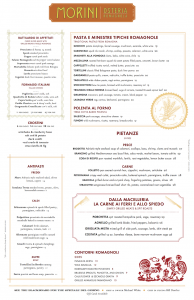Writing Menus Like A Journalist
 Journalists are taught to speak clearly, directly, and with purpose. Chefs are taught to let their food speak for them. While a great dish can truly inspire even the most dormant of taste buds, this statement is not necessarily accurate. Chefs do speak for their food – some do a better job than others – but all convey their food through the use of a menu. Though the menu may seem as a simple listing of facts, a good menu does so much more as it leads customers along the specific dining path the owner personally creates. The menu allows the chef or restaurant owner to direct customer spending in the way that best suits the restaurant’s interests. If used appropriately, the menu can act as the restaurant’s most efficient advertising platform.
Journalists are taught to speak clearly, directly, and with purpose. Chefs are taught to let their food speak for them. While a great dish can truly inspire even the most dormant of taste buds, this statement is not necessarily accurate. Chefs do speak for their food – some do a better job than others – but all convey their food through the use of a menu. Though the menu may seem as a simple listing of facts, a good menu does so much more as it leads customers along the specific dining path the owner personally creates. The menu allows the chef or restaurant owner to direct customer spending in the way that best suits the restaurant’s interests. If used appropriately, the menu can act as the restaurant’s most efficient advertising platform.
Menu Copy
The way in which a menu describes a dish can move the hunger from a diner’s stomach to the eyes, and appealing copy can provide exceptional returns for a restaurant. Below, I describe how Nolita restaurant Osteria Morini expertly constructs their menu to not only attract the diner, but also to tell the diner what to order.
Speak plainly
This concept is particularly important when dealing with restaurants that specialize in foreign cuisines. In this case, the cuisine is authentic Italian. Osteria Morini uses the seductive quality of the Italian language to entice the diner with words such as “Pasta E Minestre Tipiche Romagnole” but is smart to translate in the less sensual but just as important description of “Traditional Pastas from Romagna.” In this way, the restaurant cleverly draws your eye with the new and different and then successfully keeps it there by providing an English translation. This combination of authentic Italian with plain English can spell dollars for the restaurant, as customers are more likely to take a chance with a new and exciting and likely expensive dish.
Speak directly and with purpose
To the less experienced restaurateur, it is difficult to constrain the delicious descriptions of a menu into just one page, but this component of menu planning is crucial. Just like a strong article, menus should welcome, not burden, the reader. The more copy on a menu, the more likely the diner is to become overwhelmed, and just pick one main dish at random. But a well-versed restaurateur knows this is not the way to a profitable business, as it is important to subconsciously suggest pairings and multiple (not one) dishes to a diner. Osteria expertly conveys this concept, in the way it breaks up its simple yet descriptive cuisine in its one page menu. It starts the eye on the left corner of the menu with the appetizers, ensuring that diners see this section instead of just flipping the page over to the entrée section. Then it moves the diner’s eye to the right, exposing the creamy pastas and polenta. Finally, it draws the eye down to the entrée section, which in itself, is compartmentalized by protein (meat, fish, and grilled meats). With this placement, the chef takes the diner’s eye through the culinary path of his choosing. By the end of this journey, the diner will have a clear idea of an appetizer and wine pairing, along with a pasta and complimentary protein, not of his choosing but that of the chef’s. The menu has effectively advertised and sold a 3-course meal to a diner simply by using concise language and appropriate product placement.

